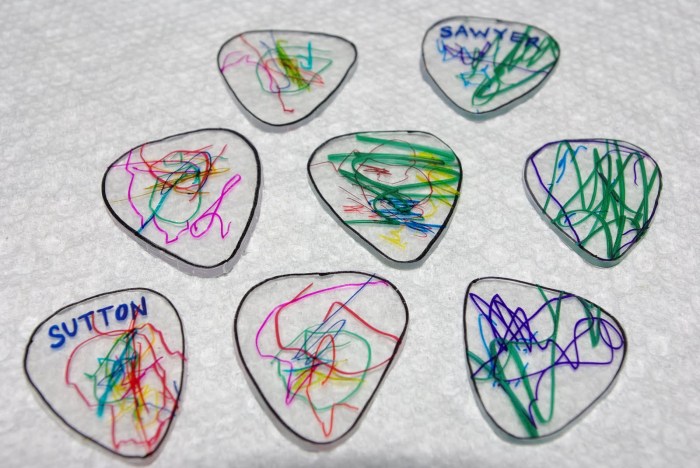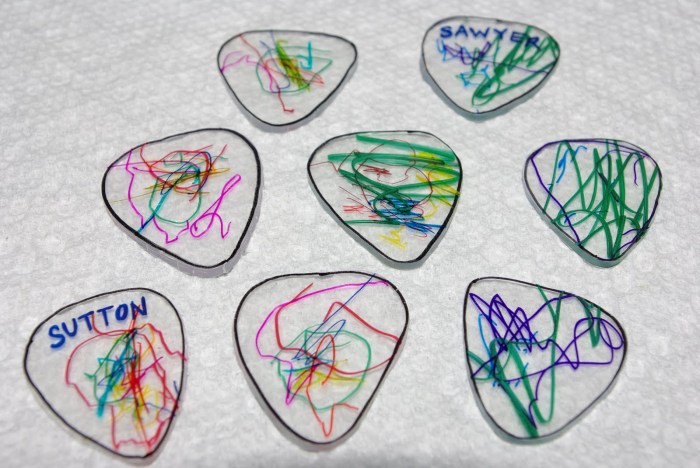DIY guitar pick: It’s more than just a piece of plastic; it’s a gateway to personalizing your playing experience. From the humble beginnings of tortoise shell to the endless possibilities of modern materials, guitar picks have evolved alongside music itself. Crafting your own picks allows you to fine-tune your sound, express your creativity, and even save money.
This guide delves into the world of DIY guitar picks, covering everything from material selection and design to crafting techniques and customization options. Whether you’re a seasoned musician seeking unique sounds or a beginner eager to explore the creative process, this comprehensive guide will empower you to create picks that are as individual as your playing style.
Materials for DIY Guitar Picks

The right material for your DIY guitar picks can significantly impact their feel, sound, and durability. Experimenting with different materials is part of the fun! Here’s a guide to common and unconventional options:
Plastics
Plastics are a popular choice for guitar picks due to their versatility and affordability. They come in various thicknesses, colors, and textures, allowing you to find the perfect match for your playing style.
- Acrylic: This is a common material for guitar picks. It’s durable, scratch-resistant, and offers a bright, clear sound. Acrylic picks are available in a wide range of colors and can be easily shaped.
- Polycarbonate: Polycarbonate is another durable plastic known for its impact resistance. It’s often used for making guitar picks with a more flexible feel. Polycarbonate picks tend to produce a warmer, rounder tone.
- Celluloid: Celluloid is a classic pick material, known for its warm, smooth tone. It’s a bit more brittle than acrylic or polycarbonate, but it offers a unique feel and sound.
- Ultem: Ultem is a high-performance thermoplastic with excellent durability and strength. It’s often used for guitar picks that require high impact resistance, such as those used for aggressive playing styles.
You can find plastic sheets for guitar picks at craft stores, online retailers, or even at hardware stores. Look for sheets labeled “acrylic,” “polycarbonate,” “celluloid,” or “Ultem.”
Wood
Wooden guitar picks offer a unique feel and sound, with a warm, natural tone. They are typically thicker than plastic picks, providing a more substantial feel in your hand.
- Hardwoods: Hardwoods like maple, oak, walnut, and ebony are popular choices for guitar picks. They are durable and produce a bright, resonant tone. Hardwoods tend to be more expensive than softwoods.
- Softwoods: Softwoods like pine, cedar, and spruce are more affordable but less durable than hardwoods. They produce a softer, warmer tone. Softwoods are a good option for experimenting with different shapes and sizes.
You can source wood for guitar picks from lumberyards, craft stores, or online retailers. Look for scraps or offcuts of wood, as these are often more affordable.
Metal
Metal guitar picks offer a unique feel and sound, with a bright, cutting tone. They are typically heavier than plastic or wooden picks, providing a more aggressive feel.
- Stainless Steel: Stainless steel is a durable and corrosion-resistant metal, making it a popular choice for guitar picks. It produces a bright, cutting tone and can withstand heavy use.
- Brass: Brass is a relatively soft metal that produces a warm, mellow tone. It’s often used for guitar picks that are designed to create a vintage or “dirty” sound.
- Copper: Copper is another soft metal that produces a warm, mellow tone. It’s often used for guitar picks that are designed to create a unique, earthy sound.
You can find metal sheets for guitar picks at hardware stores, online retailers, or metalworking supply stores.
Unconventional Materials
Don’t be afraid to experiment with unconventional materials for your DIY guitar picks! Here are a few ideas:
- Leather: Leather picks offer a unique feel and sound, with a warm, natural tone. They are typically thicker than plastic picks, providing a more substantial feel in your hand. You can find leather scraps at craft stores or online retailers.
- Cork: Cork picks are surprisingly durable and offer a unique, soft feel. They produce a warm, mellow tone. You can find cork sheets at craft stores or online retailers.
- Bone: Bone picks offer a warm, natural tone and a unique feel. They are typically thicker than plastic picks, providing a more substantial feel in your hand. You can find bone scraps at craft stores or online retailers.
Remember, the possibilities are endless! Experiment with different materials and see what sounds best for you.
DIY Guitar Pick Making Techniques

Now that you have your materials, it’s time to dive into the exciting world of crafting your own custom guitar picks. There are several methods to choose from, each offering a unique combination of complexity, equipment requirements, and creative possibilities.
Hand-Cutting
Hand-cutting is the most basic and accessible technique, requiring minimal tools and offering a great way to experiment with different shapes and sizes.
- Choose your material: Start with a sheet of your preferred material, such as celluloid, acrylic, or even leather.
- Sketch your design: Draw the desired pick shape onto the material using a pencil or marker.
- Cut out the shape: Use a sharp utility knife or a pair of scissors to carefully cut along the Artikel of your design.
- Sand the edges: Once you have the rough shape, use sandpaper to smooth out the edges and create a comfortable playing surface. Start with coarser grit sandpaper and gradually move to finer grits for a polished finish.
- Add finishing touches: You can add decorative elements like beveling or rounded edges using sandpaper or a file.
Using a Router
For more precise shapes and faster production, using a router is a great option. However, this technique requires some woodworking experience and proper safety precautions.
- Prepare a template: Create a template of your desired pick shape using a material like plywood or acrylic.
- Secure the template: Attach the template securely to your work surface.
- Set up the router: Install a router bit with a small diameter to cut the pick shape. Adjust the router’s depth to match the desired pick thickness.
- Cut the pick shape: Carefully guide the router along the template’s edge, ensuring smooth and consistent movement.
- Sand and finish: Use sandpaper to smooth out any rough edges and achieve a polished finish.
Laser Cutting
For highly detailed and intricate designs, laser cutting offers unparalleled precision and speed. This technique requires access to a laser cutter and involves sending a digital design file to the machine.
- Create your design: Use a vector graphics program like Adobe Illustrator or Inkscape to create a detailed design of your pick.
- Prepare the file: Export your design in a format compatible with the laser cutter, such as SVG or DXF.
- Set up the laser cutter: Load your material into the laser cutter and adjust the laser settings according to the material’s properties.
- Cut the design: Send the design file to the laser cutter, and it will automatically cut the pick shape with high precision.
- Finishing touches: Depending on the material, you may need to sand the edges or apply a finishing coat to enhance the pick’s appearance and durability.
DIY Guitar Pick Resources
The world of DIY guitar pick making is full of passionate individuals sharing their knowledge and creativity. There are numerous online resources and communities dedicated to this craft, providing valuable information, inspiration, and support.
Online Resources and Communities
This section highlights some of the most popular online resources and communities dedicated to DIY guitar pick making. These platforms offer a wealth of information, from tutorials and guides to discussions and inspiration.
- Reddit: The r/DIYGuitar subreddit is a vibrant community where guitarists and pick makers share their projects, ask questions, and discuss various aspects of guitar pick making. You can find numerous tutorials, guides, and discussions on different pick materials, shapes, and designs.
- Guitar Forums: Many guitar forums, such as the Guitar Forum at Ultimate Guitar, have dedicated sections or threads for DIY guitar pick making. These forums are excellent places to connect with other pick makers, exchange ideas, and seek advice.
- Facebook Groups: Several Facebook groups are dedicated to DIY guitar pick making, such as “DIY Guitar Picks” and “Custom Guitar Picks.” These groups provide a platform for sharing projects, asking questions, and finding inspiration from other members.
- YouTube: YouTube is a treasure trove of DIY guitar pick making tutorials. Search for “DIY guitar pick” and you’ll find countless videos covering various techniques, materials, and designs. Many creators offer step-by-step instructions and valuable tips.
Tutorials, Guides, and Inspiration
There are many online resources that provide detailed tutorials and guides for making your own guitar picks. These resources offer step-by-step instructions, tips, and tricks to help you create high-quality picks.
- Instructables: Instructables is a website dedicated to DIY projects, including guitar pick making. You can find various tutorials covering different materials, techniques, and designs. Many creators share their projects and provide detailed instructions with images and videos.
- Pinterest: Pinterest is a visual search engine where you can find numerous DIY guitar pick ideas and inspiration. You can browse through images of different pick shapes, materials, and designs to spark your creativity.
- Blogs and Websites: Many guitarists and pick makers maintain blogs and websites where they share their knowledge and experiences with DIY guitar pick making. These resources often include tutorials, guides, and reviews of different materials and techniques.
Suppliers of Materials, Tools, and Equipment
Finding the right materials, tools, and equipment is crucial for successful DIY guitar pick making. Many online retailers specialize in supplying these items.
- Amazon: Amazon offers a wide selection of materials, tools, and equipment for DIY guitar pick making. You can find various types of plastics, acrylics, wood, and other materials, as well as tools like punches, cutters, and sanding tools.
- Etsy: Etsy is a marketplace for handmade goods, where you can find unique and handcrafted materials for guitar pick making. Many sellers offer a wide range of plastics, acrylics, and other materials, often with custom options and designs.
- Specialty Retailers: Several online retailers specialize in supplying materials and tools for DIY guitar pick making. These retailers often offer a wider selection of specialized materials and tools, along with expert advice and support.
The Future of DIY Guitar Picks
The world of DIY guitar picks is evolving rapidly, driven by technological advancements and a growing desire for customization and sustainability. From 3D printing to innovative materials, the future of DIY guitar picks holds exciting possibilities for guitarists of all levels.
Emerging Trends and Innovations, Diy guitar pick
The DIY guitar pick landscape is being reshaped by emerging trends and innovations, particularly in the realm of 3D printing and advanced materials. 3D printing offers unparalleled customization, allowing guitarists to create picks with unique shapes, sizes, and even intricate designs. This opens up a world of possibilities for experimenting with pick geometry and finding the perfect fit for individual playing styles.
- 3D Printing: 3D printing allows for the creation of intricate designs, including custom shapes, sizes, and textures, enabling guitarists to tailor their picks to their specific playing style and preferences.
- Advanced Materials: Experimentation with advanced materials like carbon fiber, bamboo, and recycled plastics offers enhanced durability, unique sonic qualities, and environmentally conscious options for DIY pick makers.
Sustainability and Environmental Friendliness
Sustainability is becoming increasingly important in the music industry, and DIY guitar pick making is no exception. There’s a growing movement towards creating picks from recycled materials and using eco-friendly manufacturing processes. This approach not only minimizes environmental impact but also fosters a sense of community and responsibility among guitarists.
- Recycled Materials: Utilizing recycled materials like plastic, wood, and even coffee grounds reduces waste and promotes a circular economy in the guitar pick industry.
- Biodegradable Options: Exploring biodegradable materials like cornstarch and plant-based polymers provides a sustainable alternative to traditional plastic picks, ensuring they decompose naturally over time.
Predictions for the Future
The future of DIY guitar picks is likely to be characterized by continued innovation, personalization, and sustainability.
- Increased Customization: Expect to see even greater customization options with the integration of smart materials and sensors, allowing guitarists to adjust pick properties like thickness, stiffness, and even sound in real-time.
- Collaborative Design: Online platforms and communities will facilitate collaborative design efforts, where guitarists can share their creations, exchange ideas, and contribute to a collective pool of innovative pick designs.
- Sustainable Practices: The focus on sustainability will likely lead to a shift towards using locally sourced materials, minimizing packaging, and adopting closed-loop manufacturing processes.
The journey of creating your own guitar picks is a rewarding one, offering a chance to explore your artistic side and personalize your playing experience. From the satisfaction of crafting a unique pick to the joy of discovering new sonic possibilities, the world of DIY guitar picks is brimming with potential. So, grab your tools, gather your materials, and let your creativity flow – the perfect pick for your playing style awaits.
Creating your own guitar pick is a fun and rewarding DIY project. You can experiment with different materials and shapes to find what works best for your playing style. Just remember, if you’re using a material like metal, be careful not to get any sharp edges that could cut your fingers. If you’re struggling with water retention, you might want to consider researching potassium sparing diuretics as they can help regulate your body’s fluid balance.
Back to your guitar pick, once you’ve got your perfect shape, you can personalize it with paint, markers, or even glitter!

